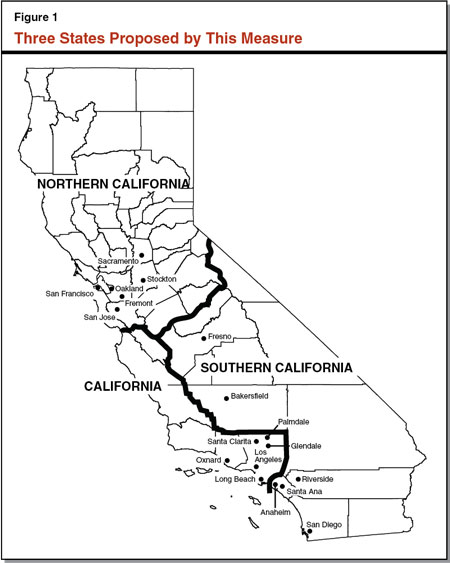Initiative to break up California on November ballot
The November general election ballot will include a proposition that does not authorize new bonds, change criminal penalties, nor propose or modify taxes. Voters will be asked whether to split California into three separate states.
Last week, the Secretary of State’s office announced that the initiative to divide the state was eligible for the fall ballot.
Financier and venture capitalist Timothy Draper proposed it in October 2017, and the Secretary of State confirmed that the required signatures had been obtained.
Dividing California into smaller states is not a new or original concept. In 1859, one effort got to Washington, D.C. but Congress took no action on it during or after the Civil War. Nor is this Draper’s first effort to reshape California. In 2014, his proposal for six states did not have sufficient signatures to qualify for a ballot contest.

Courtesy of the Legislative Analyst’s Office
In his submission letter, Draper wrote, “Political representation of California’s diverse population and economies has rendered the state nearly ungovernable … The citizens of the whole state would be better served by three smaller state governments while preserving the historical boundaries of the various counties, cities, and towns.”
If approved, and many steps beyond the ballot vote will be necessary, the initiative would create Northern California, California and Southern California.
The initiative creates the boundaries for each new state by specifying which counties would be assigned to each state. Language also sets the procedure for the transition from one to three states and the legislative consent to the U.S. Congress for the new states.
Southern California would include Riverside County and 11 other counties: Fresno, Imperial, Inyo, Kern, Kings, Madera, Mono, Orange, San Bernardino, San Diego and Tulare. Its population would be about 13.9 million. Each state is about equal in population.
In a press release with the announcement of the initiative’s eligibility, Peggy Grande, spokesperson for Citizens for Cal 3, said, “The growing discontent with the ineffectiveness of the current state government system is apparent with the success of this first step. All Californians deserve more from their state, and with Cal 3, more regional responsiveness and more meaningful results will create a promising future for everyone.”
The last state to emerge from an existing and larger state was West Virginia in 1863. However, the Civil War played a huge role in the Congressional approval of this action.
Earlier in the new republic, the states of Kentucky and Maine originated from Virginia and Massachusetts.
Initial reception of the initiative has been skeptical. Not only are the legal hurdles Byzantine, but practical issues of governance must be addressed. These would include the distribution of current state debt, for example.
In a preliminary evaluation of the proposal in October 2017, the state’s Legislative Analyst noted that many areas of the state are served with water that originates elsewhere.
“[W]ater does not naturally appear in California where demand is highest. Much of California’s rain and snow falls in water basins (watersheds) in the north, while much of the demand for water is in the south,” the report said.
Examples of other issues include the location of state prisons, as well as determining in-state residency for students currently enrolled in a state college or university in another region of California.
“The California state government isn’t too big to fail, because it is already failing its citizens in so many crucial ways,” Grande said. “The reality is that for an overmatched, overstretched and overwrought state government structure, it is too big to succeed. Californians deserve a better future.”
Political pundits are not so confident that the idea will be easily approved at the national level, even if state voters say yes. Two more states create four new senators. Partisanship will view this as an opportunity or a threat.
Further, legal issues will be raised, such as does the initiative satisfy the requirement of state legislative approval even though initiatives are voted on by the entire state population.
For more information, visit Cal3.com, @YesOnCal3 on Twitter, @VoteCal3 on Facebook and Instagram.









